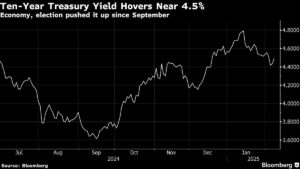Navigating the Current Landscape of Treasury Yields and Economic Indicators
In today’s financial landscape, market participants are closely monitoring the 10-year U.S. Treasury yield, which has become a critical indicator as President Trump aims to lower interest rates. Despite this goal, recent trends suggest that yields may not decline substantially in the near future.
Economic Indicators Still Pointing Upward
Recent labor market data indicates that job growth is robust, with payroll numbers expanding steadily. In January, the job market showed resilience, raising concerns that the Federal Reserve may not feel pressured to cut interest rates anytime soon. This directly impacts the borrowing costs for consumers and businesses alike, as the benchmark 10-year Treasury yield serves as a baseline for most loans.
Inflation expectations are also on the rise. According to a survey conducted by the University of Michigan, consumers expect inflation to exceed 4% over the next year, more than double the Federal Reserve’s target. This sentiment fuels bond traders’ expectations that yields will remain elevated, trapped in a range until more clarity arises regarding economic trajectories.
Caution Awaits amid Uncertainty
As the Treasury Department maintains stable quarterly note and bond auctions, relieving some market supply concerns, analysts remain vigilant. The contrasting policies of the current administration compared to its predecessor create a landscape full of uncertainty. President Trump’s proposed tariffs could complicate efforts to achieve lower Treasury yields as they inherently risk pushing inflation higher.
"Bessent’s aim to sustain lower 10-year Treasury yields might conflict with the administration’s broader economic goals, particularly if it seeks to address the trade deficit aggressively," notes Simon White, a macro strategist.
What Lies Ahead?
Looking forward, various significant economic reports are on the horizon that will further influence Treasury yields and market sentiment:
- February 10: New York Fed 1-Year Inflation Expectations
- February 11: NFIB Small Business Optimism Index
- February 12: Consumer Price Index (CPI) Data
- February 13: Producer Price Index (PPI) and Initial Jobless Claims
- February 14: Retail Sales Data
As we await these pivotal data points, attention will also be focused on Fed Chair Jerome Powell’s testimony before Congress this week. With inflation hovering at a measured pace of approximately 2.9% year-over-year in January, the outcomes of these reports could tip market expectations.
The Big Picture: Cautious Optimism
As market dynamics evolve, it’s crucial for investors to tread carefully. Ed Al-Hussainy, a global rates strategist, emphasizes, “We are not in an environment where you want to make big bets.” Navigating through this uncertainty requires a balanced approach, leveraging insights from varying economic indicators to formulate an effective investment strategy.
At Extreme Investor Network, we strive to equip investors with the information necessary to make informed decisions in such volatile market conditions. When volatility seems high, our insights can help clarify the noise in the markets.
Stay updated with our investment strategies and analyses to gain an edge in today’s complex market landscape. Your financial well-being is our mission.

